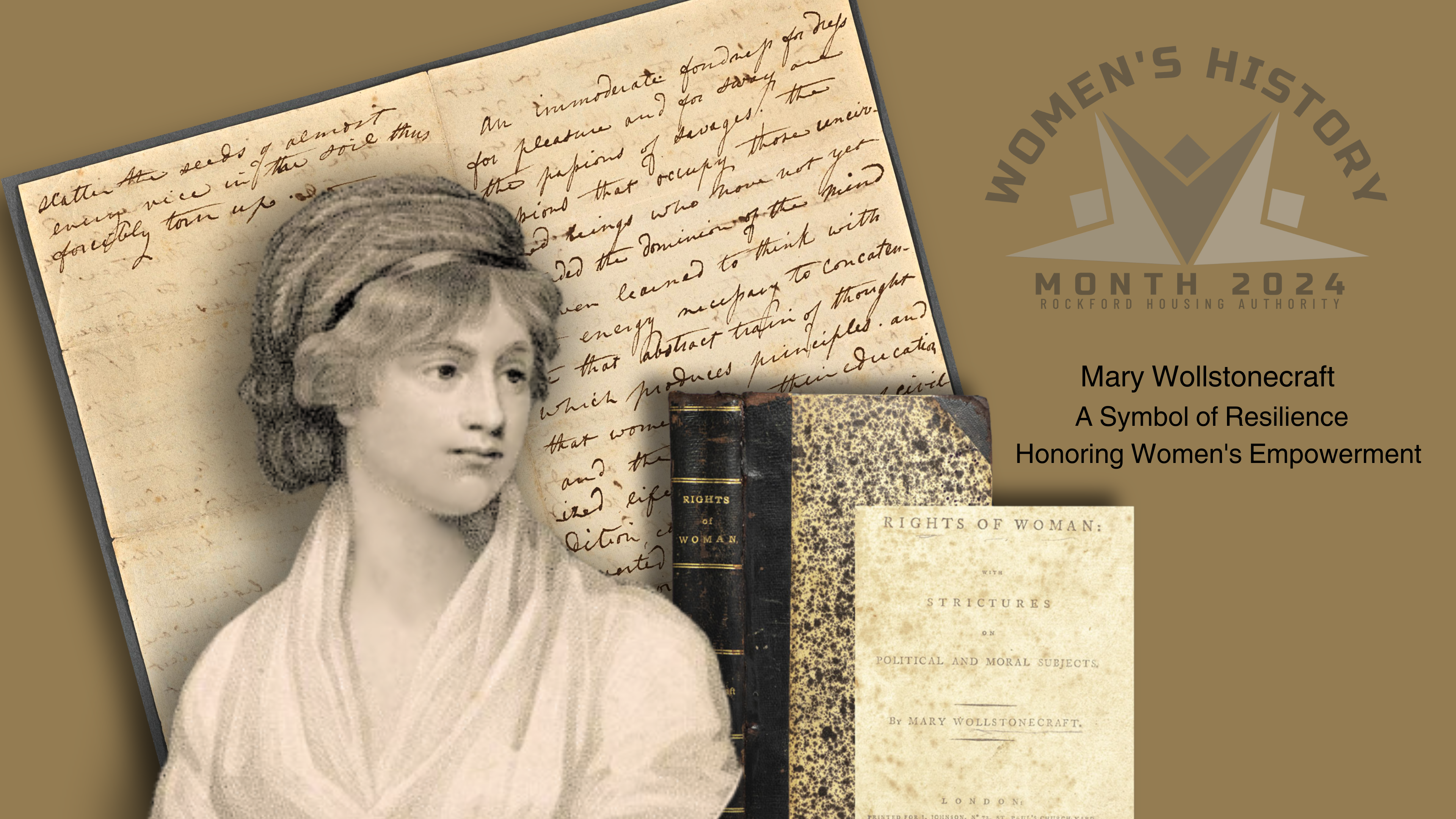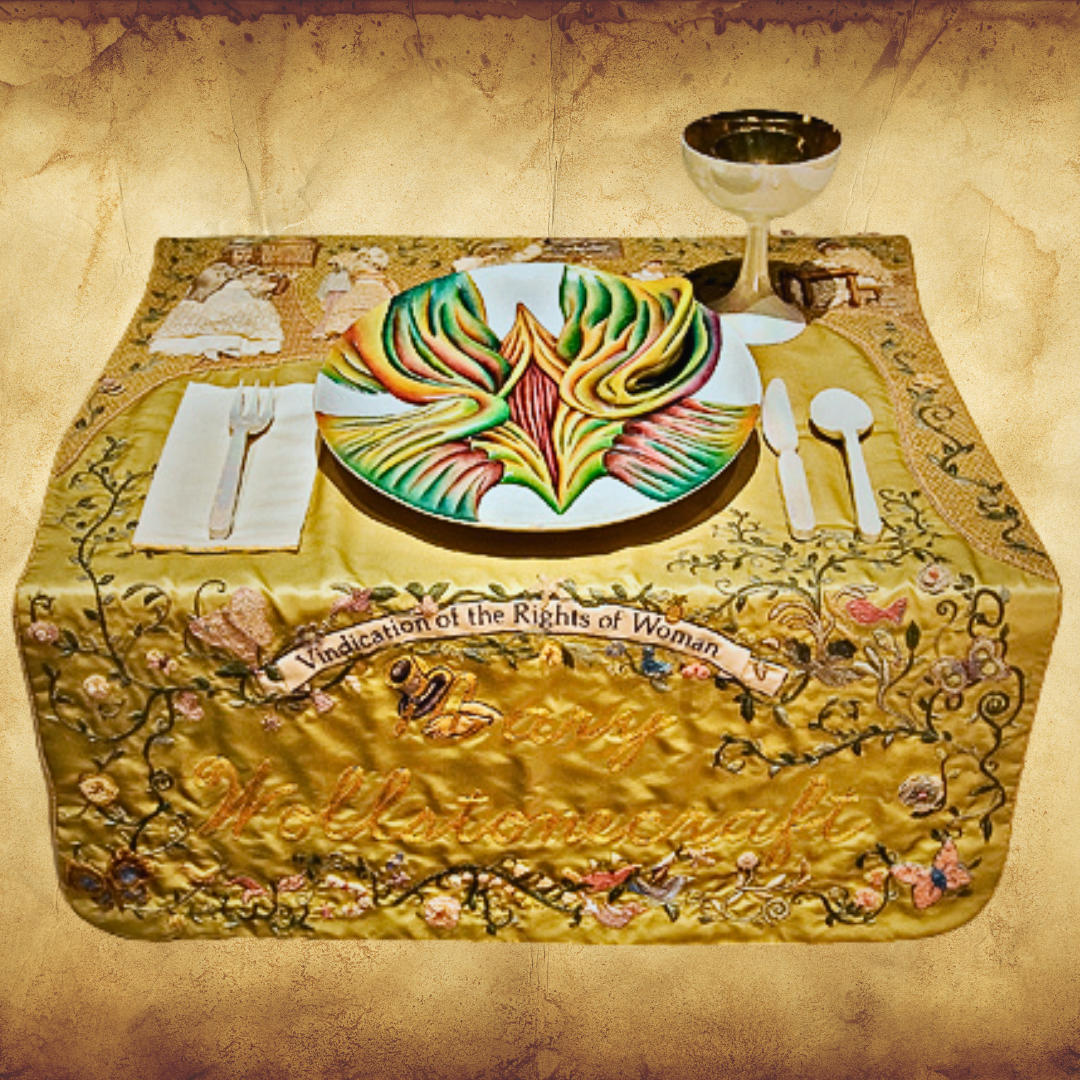- Home
- About Us
- Housing
- Resources
- Contact Us
-
-
-
Address: 223 S. Winnebago Street Rockford, IL 61102
Phone: 815-489-8500
-
-
- Updates
-

Address: 223 S. Winnebago Street Rockford, IL 61102
Phone: 815-489-8500
Address: 223 S. Winnebago Street Rockford, IL 61102
Phone: 815-489-8500


In commemorating Women’s History Month 2024, the Rockford Housing Authority is proud to highlight Mary Wollstonecraft, an English writer who passionately advocated for educational and social equality for women. She promoted enhancing women’s status through political reforms, such as the complete transformation of national educational systems. Wollstonecraft was convinced that these changes would have positive impacts on society overall.
Throughout her life, Mary Wollstonecraft was a trailblazer for women’s rights and education. In her groundbreaking work, A Vindication of the Rights of Woman (1792), she argued passionately for gender equality and the importance of providing women with access to education on par with men. Wollstonecraft’s experiences as a teacher and governess gave her unique insights into the inequalities faced by women in society, and her writings continue to inspire and empower women around the world to this day. Starting in 1788, she ventured into translation for the London publisher Joseph Johnson, who released multiple of her writings, such as the novel Mary: A Fiction (1788). Her legacy as a feminist pioneer and literary figure continues to resonate in the modern world, reminding us of the enduring importance of fighting for equality and justice for all. Her influential works sparked important conversations and paved the way for future generations of feminists.
Her story is a one with trials and tributes as she left England to observe the French Revolution in Paris, where she lived with an American, Captain Gilbert Imlay. In the spring of 1794 she gave birth to a daughter, Fanny. The following year, distraught over the breakdown of her relationship with Imlay, she attempted suicide.
Upon returning to London, Wollstonecraft resumed working for Joseph Johnson and became part of a significant radical group that met at his residence. The group included influential figures like William Godwin, Thomas Paine, Thomas Holcroft, William Blake, and later, William Wordsworth after 1793. In 1796, she initiated a relationship with Godwin, and they got married, when Mary was pregnant. Although their marriage was brief, it was happy. Sadly, Mary passed away just 11 days after giving birth to her second daughter, Mary Wollstonecraft Shelley, renowned as the author of “Frankenstein.”
History of Mary’s Work
Among Wollstonecraft’s later notable works are “Letters Written During a Short Residence in Sweden, Norway, and Denmark” (1796), a travelogue with a blend of sociology and philosophy, and “Maria; or, The Wrongs of Woman” (1798), an unfinished novel published posthumously that serves as a sequel to “A Vindication of the Rights of Woman.”
 In addition to her advocacy work, Wollstonecraft was also a talented writer of fiction. Her novel Mary: A Fiction (1788) is a poignant exploration of the challenges faced by women in a society that often restricted their opportunities for personal and intellectual growth.
In addition to her advocacy work, Wollstonecraft was also a talented writer of fiction. Her novel Mary: A Fiction (1788) is a poignant exploration of the challenges faced by women in a society that often restricted their opportunities for personal and intellectual growth.
Another piece of work from Mary was; “A Vindication of the Rights of Woman” a pioneering feminist piece. In 1792, Wollstonecraft criticized the educational system of her era for undermining women’s capabilities. She suggested that if girls had equal educational opportunities as boys, they could succeed not only as wives and mothers but also in diverse professions. Unlike her contemporaries who focused on enhancing women’s education, Wollstonecraft uniquely advocated for political reforms, including revamping national educational systems, to empower women. She believed that such changes would have a positive impact on society as a whole. In its dedicatory letter, Wollstonecraft states, “my main argument is built on this simple principle, that if she be not prepared by education to become the companion of man, she will stop the progress of knowledge and virtue”
Through her eloquent writing and bold activism, Mary Wollstonecraft left a lasting impact on history, reminding us of the power of individuals to create positive change and shape a more equitable future for all.
Mary Wollstonecraft at “The Dinner Party”
The Dinner Party stands as an installation piece created by the American feminist artist Judy Chicago. It is recognized as a groundbreaking feminist artwork, serving as a symbolic representation of women’s history throughout civilization. The artwork features 39 intricate place settings arranged on a triangular table, depicting 1,038 women from history. While 39 women are honored with place settings, an additional 999 names are engraved on the Heritage Floor beneath the table.
groundbreaking feminist artwork, serving as a symbolic representation of women’s history throughout civilization. The artwork features 39 intricate place settings arranged on a triangular table, depicting 1,038 women from history. While 39 women are honored with place settings, an additional 999 names are engraved on the Heritage Floor beneath the table.
Wollstonecraft’s runner and plate highlight the author’s strong character and compare her advocacy for women’s equality against the main 18th-century perspective. Chicago crafted the runner using various needlework techniques like needlepoint, petit point, embroidery, crochet, a raised embroidery style often depicting rustic scenes. This intricate needlework tells the story of Wollstonecraft’s life visually, hinting at the constraints executed by her gendered surroundings. The table setting places Wollstonecraft’s literary contributions within the historical context, where women’s work was often dismissed as insignificant and lacking depth.
Throughout the artwork, Chicago incorporates symbols commonly linked to the domestic realm, like apples, birds, and flowers, to emphasize the insignificance of women’s lives in the eighteenth century. The plate’s three-dimensional aspect contrasts with these domestic elements, symbolizing Wollstonecraft’s strength and intelligence. Needlework scenes depict Wollstonecraft teaching female students, while the back of the artwork illustrates her tragic death during childbirth.
The front of the runner features the glowing letter “M,” entwined with two symbols that symbolize Wollstonecraft’s legacy – a top hat and a gauntlet. The gauntlet, a type of glove famously refused by Wollstonecraft on her deathbed, symbolized women’s delicacy. She boldly stated, “I have thrown down the gauntlet. It is time to restore women to their lost dignity and to make them a part of the human species” (Chicago, Embroidering Our Heritage, 212).
At RHA, we draw inspiration and empowerment from the remarkable story and writings of Mary Wollstonecraft. Her legacy as a pioneering advocate for women’s rights continues to guide us in our mission to create inclusive and empowering environments for all residents. Just as Wollstonecraft bravely challenged social norms and fought for equality, we too strive to break down barriers and create opportunities for everyone, especially mothers and families, to thrive.
Embracing women’s history means acknowledging the struggles and triumphs of women throughout time, recognizing the difficulties and tones of their journeys. By learning from both the good and bad parts of history, we can better understand the challenges women have faced and continue to face, and work toward creating a more impartial and inclusive society. RHA is committed to honoring the legacy of trailblazers like Mary Wollstonecraft by championing gender equality and empowerment in all aspects of our work. Together, we can pave the way for a future where every individual, regardless of gender, has the opportunity to flourish and succeed.

To continue to create strategic partnerships with community stakeholders, design a diverse housing portfolio, leverage social service programming to unite and ensure residents are provided with safe and nurturing environments that lead to self-sufficiency, responsibility, and individual empowerment.
This Earth Day, let's unite for a brighter future!
Today, we're reminded of the importance of our planet and the role each of us plays in protecting it.
View the RHA Earth Day 2024 Blog here:
https://rockfordha.org/earth-day-2024/
Effective today, Monday, April 22, 2024, the current RHA Low-Income Public Housing (LIPH) Family Waiting List will open until further notice. Pre-applications can be completed online at https://www.rockfordhousingauthority.com/ and are available at 223 S. Winnebago Street Rockford, IL 61102.
#RHA
Let's come together to celebrate Diversity Month by acknowledging the beauty found in our distinct backgrounds, viewpoints, and identities. #RHA #MovingForwardTogether

Within 5 years the RHA will re-establish itself as high performing agency that is a leader in housing and sustainable communities by developing additional, non-HUD revenue streams, increasing our asset base and offering state of the art resident initiatives.